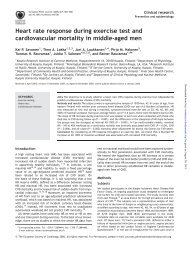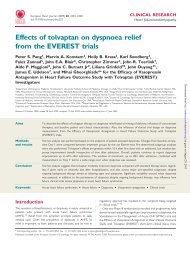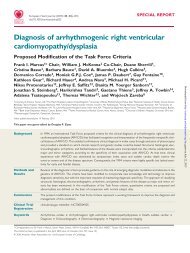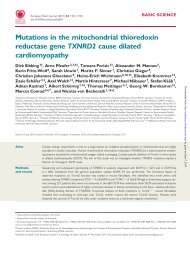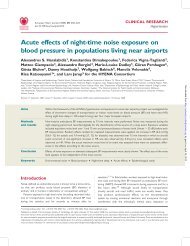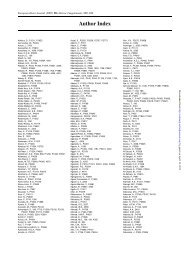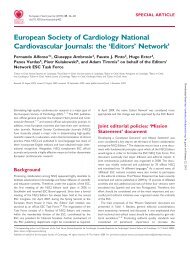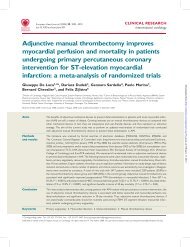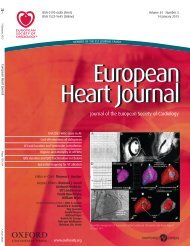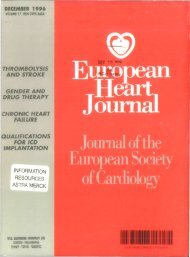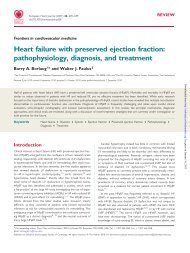Monday, 1 September 2008 - European Heart Journal
Monday, 1 September 2008 - European Heart Journal
Monday, 1 September 2008 - European Heart Journal
Create successful ePaper yourself
Turn your PDF publications into a flip-book with our unique Google optimized e-Paper software.
270 Prognostic predictors in acute heart failure / Restenosis: is there an alternative to drug-eluting stents?<br />
the degree of oedema showed no correlation to the duration of dyspnea prior to<br />
presentation (r=-0.168, p=0.393).<br />
Conclusion: Lower extremity oedema in ADHF is not primarily caused by an<br />
elevation of the hydrostatic pressure as depicted by the CVP but might mirror<br />
disease severity depicted by BNP levels. Interestingly, the extent of lower oedema<br />
can not be used as a bedside measurement of disease severity.<br />
1782 Prognostic value and changes in renal function in<br />
patients admitted with acute heart failure - results from<br />
the EVEREST program<br />
J. Blair 1 , J.C. Burnett2 ,M.A.Konstam3 , L. Grinfield4 , A.P. Maggioni5 ,<br />
K. Swedberg6 ,J.E.Udelson3 , F. Znnad7 ,T.Cook8 , M. Gheorghiade1 on behalf of the EVEREST investigators. 1Northwestern University, Internal<br />
Medicine, Division of Cardiology, Chicago, United States of America; 2Mayo Clinic, Rochester, United States of America; 3Tufts New England Medical Center,<br />
Boston, United States of America; 4Hospital Italiano, Buenos Aires, Argentina;<br />
5 6 Associazione Nazionale Medici Cardioligi, Florence, Italy; Sahlgrenska<br />
University Hospital/Oestra, Gothenburg, Sweden; 7INSERM, Nancy, France;<br />
8University of Wisconsin, Madison, United States of America<br />
Introduction: The prognostic value of admission and changes in renal function<br />
has not been well studied in patients admitted with acute heart failure.<br />
Methods: EVEREST was a prospective, international, placebo controlled trial<br />
evaluating the effects of tolvaptan, an oral vasopressin antagonist, in pts admitted<br />
with worsening heart failure and LVEF £ 40%. Pts with a Cr > 3.5 mg/dL or on<br />
hemodialysis were excluded. Pts were receiving standard medical therapy including<br />
ACE inhibitors/ARBs, beta blockers, and diuretics. The 4133 enrolled patients<br />
were grouped into quartiles of baseline BUN, Cr, eGFR, and BUN/Cr ratio, and<br />
outcomes for each quartile were reported. BUN and Cr levels were obtained during<br />
hospitalization and over the course of the study (median 9.9 months)<br />
Results: After adjustment for non-renal baseline characteristics (age, race, SBP,<br />
EF, beta blocker use, geographic region, BNP, and QRS), all four measures of<br />
renal function were highly predictive of 3-month and 1-year mortality (p 24 mg/dL) was 47% on admission,<br />
53% at discharge, and 39% at one year. Similarly, the percentage of pts with<br />
abnormal Cr (>1.1 mg/dL) was 39% on admission, 41% at discharge, and 39%<br />
at one year.<br />
One Year Unadjusted Mortality<br />
Quartile BUN Cr eGFR BUN/Cr<br />
Range Mortality Range Mortality Range Mortality Range Mortality<br />
1 ≤20 16.3% ≤1.0 16.8% >75 16.4% ≤17 19.7%<br />
2 21-26 17.4% 1.0-1.3 21.1% 59-75 21.1% 18-21 21.7%<br />
3 27-35 27.2% 1.4-1.6 29.6% 44-58 26.1% 22-25 24.6%<br />
4 >35 42.8% >1.6 40.3% ≤44 39.2% >25 37.2%<br />
Conclusion: In pts admitted with acute heart failure and reduced LVEF, baseline<br />
renal dysfunction is common, tended to worsen during hospitalization, and is an<br />
independent predictor of short- and long- term mortality.<br />
1783 The presence of an S3 is associated with an increase<br />
rate of all- cause-mortality after one year<br />
M. Potocki, T. Breidthardt, T. Klima, M. Noveanu, T. Reichlin, K. Laule,<br />
C. Stelzig, T. Boldanova, M. Christ, C. Mueller. University Hospital,<br />
Internal Medicine, Basel, Switzerland<br />
Purpose: The S3 heart sound has been shown to be diagnostic in patients presenting<br />
with acute decompensated heart failure (ADHF). We investigated the utility<br />
of the S3 heart sound to predict one year all-cause-mortality in patients presenting<br />
with dyspnea to the emergency department (ED).<br />
Methods: We analyzed the data of 287 consecutive patients with dyspnea enrolled<br />
from April 2006 to March 2007 in our emergency department. The patients<br />
received a clinical evaluation with an S3 evaluation by Audicor ® (Inovise Medical,<br />
Inc, Portland, USA). The diagnosis of ADHF was adjudicated by two independent<br />
cardiologists using all available clinical data including BNP.<br />
Results: Audicor ® results were available in 275 patients. The mean age was<br />
74±12 years and 52% were male. The median follow-up time was 372 days<br />
[IQR 153-430 days]. Hypertension, coronary artery disease, chronic kidney disease<br />
and diabetes was present in 183 (67%), 75 (27%), 72 (26%) and 51 (19%).<br />
ADHF was the adjudicated final diagnosis in 145 patients (53%). Median BNP levels<br />
were significantly higher in patients with an S3 compared to patients without<br />
S3 detection (1081 vs. 263pmol/L, p < 0.001). In the Kaplan-Meier and log-rank<br />
analyses, those patients with an S3 detected had a significantly higher one year<br />
mortality compared to the patients without an S3 (37% vs. 23%, p = 0.046). The<br />
sensitivity, specificity, positive and negative predictive value, and diagnostic accuracy<br />
of an electronic S3 for detection of ADHF were 26%, 92%, 79%, 53% and<br />
57% and for an S3 detected by physician auscultation 9%, 99%, 93%, 49% and<br />
52%. The odds ratio for one year mortality was 2.02 (p = 0.036) for the electronic<br />
detection of an S3, whereas S3 detection by physician failed to reach statistically<br />
significance.<br />
Conclusions: The presence of an electronically detected S3 is a significant predictor<br />
of one year mortality in patients presenting with dyspnea to the emergency<br />
department. The detection of S3, both by auscultation or by electronical devices,<br />
is highly specific for the diagnosis of ADHF and may improve early diagnostic<br />
accuracy in the emergency department.<br />
RESTENOSIS: IS THERE AN ALTERNATIVE TO<br />
DRUG-ELUTING STENTS?<br />
1784 Oral cilostazol prevents restenosis and repeat<br />
revascularization after percutaneous coronary<br />
stenting: A meta-analysis of 15 randomized trials and<br />
4897 patients<br />
G. Biondi-Zoccai1 ,C.Moretti1 , M. Lotrionte2 , P. Agostoni3 ,F.Sciuto1 ,<br />
P. Omede1 , A. Abbate4 ,G.Trevi1 , I. Sheiban1 . 1Turin, Italy; 2Rome, Italy; 3Antwerp, Belgium; 4Richmond, United States of America<br />
Purpose: Drug-eluting stents reduce the risk of restenosis after percutaneous<br />
coronary intervention (PCI), but may pose a risk of thrombosis. Cilostazol, an oral<br />
antiplatelet agent with pleiotropic effects including inhibition of neointimal hyperplasia,<br />
could hold the promise of preventing both restenosis and thrombosis. We<br />
systematically reviewed randomized clinical trials on the angiographic and clinical<br />
impact of cilostazol after percutaneous coronary stenting.<br />
Methods: Pertinent randomized trials were searched in BioMedCentral, CEN-<br />
TRAL, clinicaltrials.gov, EMBASE, and PubMed (January 2007). Co-primary<br />
end-points were binary angiographic restenosis and repeat revascularization,<br />
abstracted and pooled by means of random-effect relative risks (RR). Small<br />
study/publication bias was appraised with multiple methods.<br />
Results: A total of 15 randomized clinical trials were included (4897 patients,<br />
2453 randomized to oral cilostazol for 1-6 months, and 2444 randomized to control<br />
therapy or placebo), with median follow-up of 6 months. Pooled analysis<br />
showed that cilostazol was associated with statistically significant reductions in binary<br />
angiographic restenosis (18.8% for cilostazol vs 26.8% for control, RR=0.60<br />
[0.49-0.73], p



